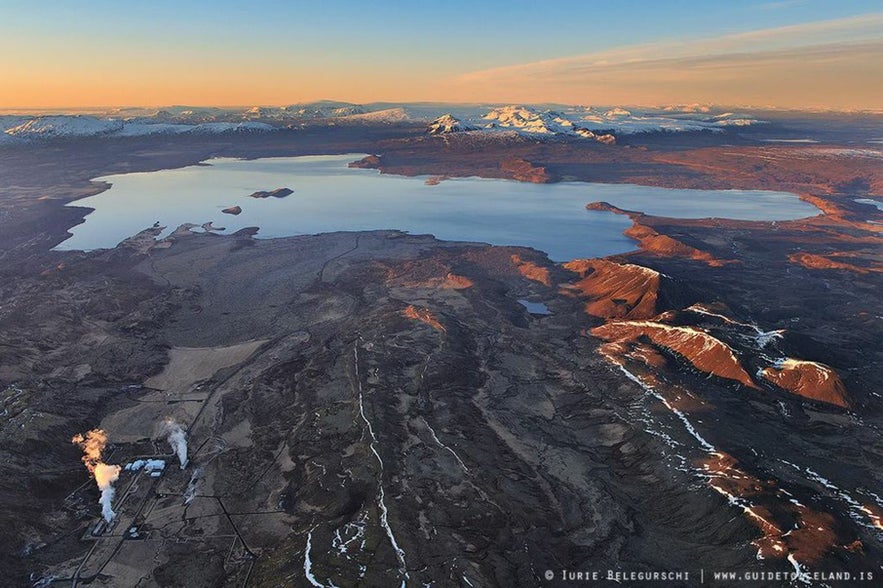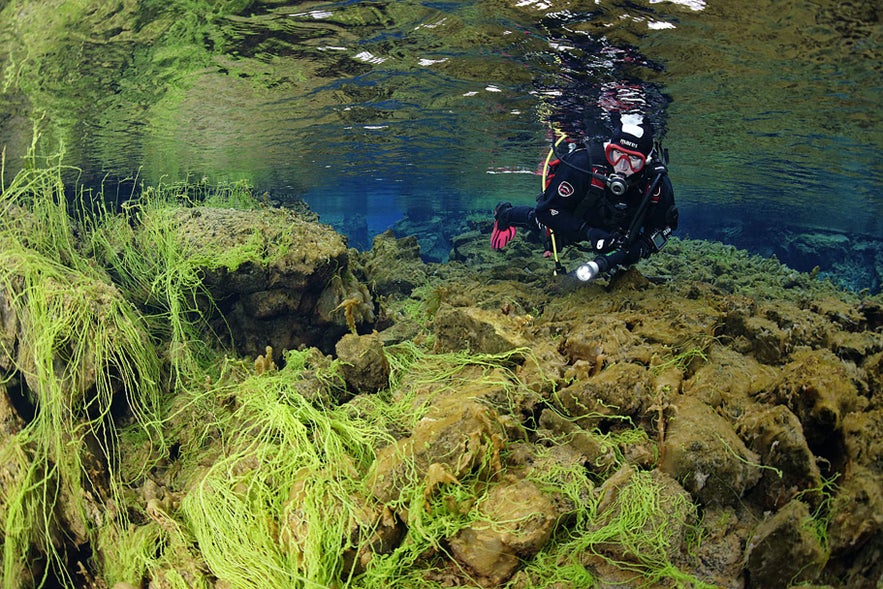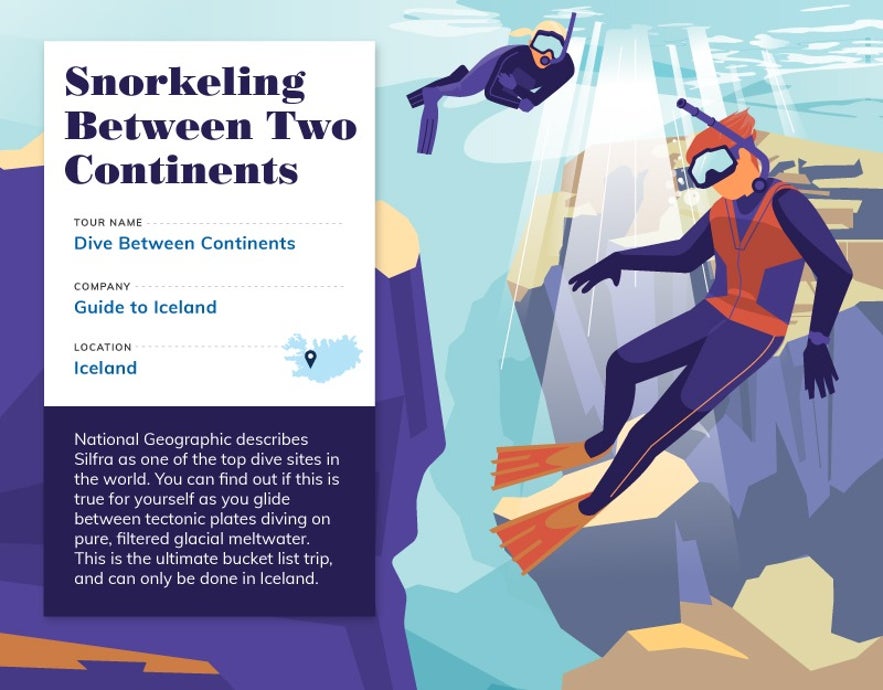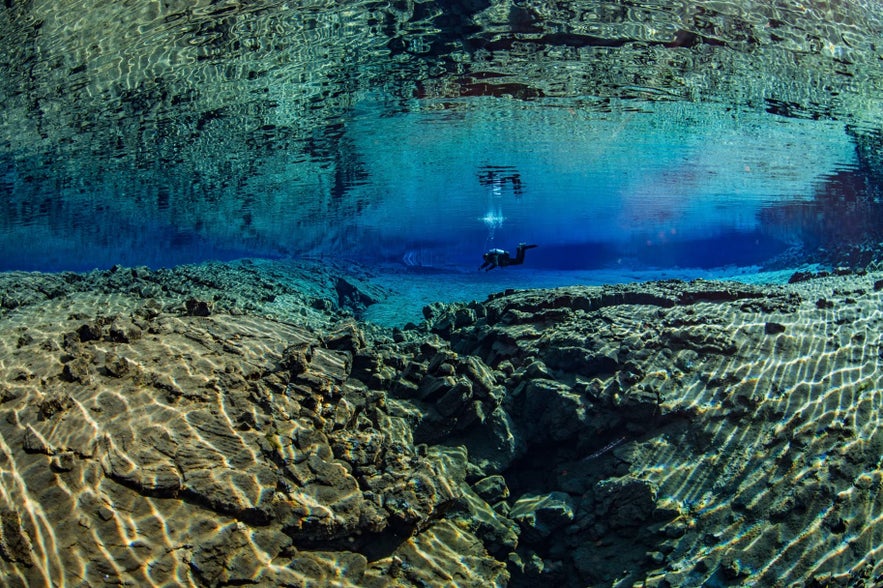
Scuba Diving and Snorkelling in Iceland

Were you ever curious about snorkelling and diving in Iceland? Well, now it's time to grab your fins and brave the cold! Read more to find out everything about the beautiful and exotic landscapes hidden just underneath the water's surface.
Be they, scuba divers, be they snorkellers, over time many will become acclimatised to certain preconceptions that Iceland, at first glance, appears to lack; namely, warm tropical waters, flexible wetsuits and an easy ride. In fact, whenever it arises in polite conversation that I’m a diver in this country, the listener will often throw me a look of daunted concern, as though I must be clinically deranged to submerge myself in such cold water so regularly.
Well, for a year now, this is what I have done as a diving and snorkelling guide. And, like many others before me, I have quickly become poignantly aware of the fantastic wonders, the depth of experience and adventure that lies beneath the blue Icelandic surface.
Going on a snorkelling or diving tour in Iceland is an experience like nothing else. I have encountered such unspeakable beauty, it defies the imagination. How often, after all, does one surface from the stomach of the earth to a rich tapestry of snowy fields, distant mountains and clear, flat water? Not often enough, I say.

The land of ice and fire is renowned for its unpredictable conditions (the weather in Iceland can go from good to bad in five minutes) its natural beauty and the people’s openness and stoic attitude to nature’s hardships. It is not surprising then that undertaking any water activity – be it scuba diving, snorkelling or surfing – Iceland presents its own unique challenges. Don’t let that deter you; the rewards far outstretch the necessary effort.
Drysuits, for instance, are essential equipment here. At certain points during these hard winters, I find them essential for just walking around in town, let alone for snorkelling. It is, however, now essential that scuba divers in Silfra have experience diving in a drysuit within the last two years.
If you are planning on scuba diving particularly and don’t have experience using a drysuit, it is essential to take a short course beforehand, if only to ensure confidence in exploring the seascapes of Iceland without a problem.
For snorkelers, guides are on hand to explain the basic principles of how a dry suit works. Donning a dry suit for the first time is an experience in itself. Don’t be surprised to find guides taping your wrist seals and putting kinky straps around the dry suit neck. It’s their job to keep you dry, and in water like this, it’s best to trust the drysuit is sealed correctly. I can assure you that once you’re in the water, any thoughts of being constrained dissipate. You’re too busy taking in the grandeur of your environment to worry about any temporary inflexibility.
Silfra Fissure Dive and Snorkel Site

The first question you are likely asking yourself is “do I go diving in Iceland or snorkelling in Iceland?” Well, whereas snorkelling is available to almost everyone, the diving tours require customers to be qualified to at least PADI Open Water Scuba Diver or the equivalent and experienced in dry suit diving. Some dive sites require higher levels of qualification, presenting more challenges and a more rooted knowledge in dry suit diving.
It is the recommendation that anyone interested in scuba diving or snorkelling in Iceland chooses to go with a registered tour operator. I can speak confidently from experience here that not only are we friendly, ready to help and license, we also know the sites a lot better than you do. As with anywhere in Iceland, wet or dry, it’s best to have a guide with you if you decide to start exploring the wilderness. Let’s keep the rescue helicopters grounded, shall we?
The second question is “where to go?” One cannot mention these activities in Iceland without revealing its most famous site; Silfra Fissure. Often touted as one of the top ten dive sites internationally, this makes it an essential stop on anyone’s visit. Silfra is approximately 60km away from Reykjavík, nestled in the Mid-Atlantic Dorsal Rift in Þingvellir National Park, Iceland’s largest park and the one covered by UNESCO World Heritage.

Here, the North American tectonic plate stretches and overshadows the near horizon, while the Eurasian tectonic plate, roughly 4km away across the mossy, volcanic field, serves as a constant reminder just how special this area really is. These plates shift 2cm apart every year, give or take, causing tension both underground and on the surface, making for incredibly volatile geology. Minor earthquakes occur every ten years or so, further sculpting the earth. Continentally speaking, this is no man’s land, a landscape still very much experiencing growing pains. All the better for those lucky enough to visit.
To add to this already sublime beauty, Öxarárfoss waterfall roars and plummets in the background, only a short walk away from the historical site of the Alþingi – or ‘parliamentary building’ – where, in 930AD, tribes of Viking clansmen met to form arguably the first democratic institution in history. Using the tectonic plate as a literal sounding board, speakers were able to read aloud unifying laws to thousands of people. Parliament in Iceland existed here until 1884 when finally it was moved to Reykjavik.
Now, don’t get me wrong, that information has little to do with snorkelling in Silfra directly, but it’s hard to imagine anywhere that quite offers such a deep insight into Icelandic culture, both to its past and present-day form. It is one of the many things that makes both snorkelling and diving in Silfra such a privilege.
 Photo from Silfra Diving Experience & Golden Circle Day Tour
Photo from Silfra Diving Experience & Golden Circle Day Tour
The fissure itself was formed after tensions under the crust opened an underwater spring, filling the new canyon with crystal clear water. This flowing spring was met by water flowing underground from Langjökull glacier, 50km north (also a spectacular spot to visit your trip). This mixture of water has had a number of effects since this process first began occurring over 12,000 years ago.
First, given that the water takes up to a century to travel from Langjökull to Silfra's entrance point, plenty of time is allowed for the water to cleanse, meaning almost perfect visibility and chemical purity.

This leads to our second point; the water at Silfra is drinkable, refreshing and delicious. As a guide, I always recommend a taste, though am quick to remind customers not to drink too much; dry suits are going to keep contained any little accidents that might happen along the way.
Third of all, this continual flow means that Silfra has a gentle current. Any snorkelers concerned about their swimming ability need not be; the drysuit will keep them buoyant on the waters’ surface, while the current smoothly directs them down the full length of the fissure. This flow also means that any sediment or floating particles kicked up by other tours will quickly be pulled away, ensuring excellent visibility within minutes.
 Photo from Silfra Diving Experience & Golden Circle Day Tour
Photo from Silfra Diving Experience & Golden Circle Day Tour
Finally, the water’s glacial origins determine Silfra's near-constant temperature, 2°C - 4°C (36°F – 39°F). This never changes, regardless of the season, though it might often appear to given the temperature outside. It’s not uncommon in winter, after all, to be preparing for a snorkel or dive in freezing conditions, and that’s something one has to keep strongly in mind. Hard as it might be to believe, getting into the water will often actually provide relief from the harsh conditions outside. As I said, the weather can be capricious.
To speak of Silfra is one thing, but to experience it is entirely another. Whether one chooses to snorkel or dive the site makes no difference in the face of the awe-inspiring sights on offer. Both parties travel the full length of Silfra, from its beginning at Big Crack (where two continents can be touched), to Silfra Hall (the widest section), through to Silfra Cathedral (the deepest) and finally, to what is described as the real blue lagoon, a natural shallow pool enclosing its own splendour.
From the beginning, snorkelers glide effortlessly over caves and rock formations, all the while transfixed by the crisp luminosity, the Caribbeanesque colours of green, yellow and tranquil blue. This is snorkelling like never before.
Divers, on the other hand, will experience a new perspective. Instead of staring down upon the fissure, divers will look upward toward a glittering surface, caught in a slit between two dark, formidable plates. At the maximum depth of 18m, this is truly a breathtaking sight. The closest I could come to describing it is scuba in space or, maybe, dreaming with a regulator in your mouth.
Snorkelling and diving in Silfra holds its own in every season. In the summer, the midnight sun rays shoot easily through the water, creating brilliant rainbow formations on the fissure’s bottom. These can only occur because the glacial water is so incredibly pure that it breaks down and bends the light just like a crystal. In wintertime, however, a blanket of snow covers the area and daylight hours become harder to find.
None of this does anything to dilute the experience; in fact, in many ways, it heightens it. Dipping into the water on a grey dawn and watching as the morning light slowly illuminates Silfra Cathedral can barely be described. It is enough even to make the most vocal of holiday pessimists feel suddenly grateful at the sheer expanse of magnificent natural finery. Nothing, and I mean nothing, wakes you up to the fact you are alive more than a sight like this.
Davidsgja (David’s Crack)
Silfra Fissure finally breaks away into Þingvallavatn, Iceland’s largest open body, freshwater lake. It is only one of many fissures in an unmapped network of caves and tunnels across the area. In the lake itself, Davíðsgjá, anglicised to David’s Crack, is deeper and darker than Silfra, falling to a staggering 116m metres. This mysterious ruggedness makes it a local favourite amongst divers.
The site only requires a shore entry and has a line in place just metres under the surface to help guide toward the fissure, which opens up at 7m. At first descent, one might believe the visibility pales in comparison to Silfra’s transparency. But as one descends deeper and deeper into the rift, particles from the lake disappear, leaving the visibility glass-like. On my first dive there, I couldn’t help but liken it to a blue Grand Canyon.
For lovers of marine life, the fish species that habituate here – trout, four kinds of Arctic char – are a more regular sighting than in Silfra, which baby fish tend to use only as a nursery.
Again though, it is the underwater landscape that draws its main pull of visitors. David’s Crack is wilder than Silfra, more foreboding, more hidden, less welcoming. It is one of many unforgettable dives in Iceland… just make sure you’re wearing a thick pair of woollen socks for it! I neglected to and after seventy minutes in the water, I was starting to feel a little unsure if I still had toes or not. Count that as an insider tip for when you arrive here.
Strytan Dive Site
Away from Thingvellir, Iceland has a host of other sites destined to pique interest. Strýtan, for example, provides another opportunity to experience how unique diving in Iceland really is.
The site was discovered in 1997 by Erlendur Bogason, a commercial and research diver who still to do this day runs personalised tours at the sites off Ystavík bay. He was also instrumental in having Strýtan made a natural reserve in 2001, the first underwater environment off Iceland to be named so. The site boasts 55m high geothermal chimneys, the top of which can be reached at 15m under the surface. Every second, over 100 litres of 72-degree celsius water pours from the top of the chimney.
Unlike in Silfra, marine life, fish and algae are rife here, due to the naturally warmer temperature of their environment. To dive here, customers must be at least an Advanced Open Water Scuba Diver, as the currents can be strong, and a good level of buoyancy control is required to prevent coming into contact with the site. Considering Strýtan is the only place on earth where divers can reach geothermal chimneys (most are to be found in the deep ocean from 2000m), it makes the qualification well worth earning prior to any trip to Iceland.
El Grillo "The Cricket" Wreck
For the passionate wreck-diver, the British oil tanker El Grillo, resting 45m below the surface in Seyðisfjörður, will easily exceed expectations. Sank by German fighters in the Second World War, February 10th 1944, the wreck is a living example of one of the few times fighting actually reached the Icelandic coast, albeit 700km from the capital, Reykjavik.
In 2002, the last of the tankers’ oil was pumped from it, leaving a clean, new and exciting dive site. Given its distance and depth, however, anyone looking to dive this site must be at least a PADI Advanced Open Water Diver, and willing to travel the width of the country. Still, nothing like a scenic drive to get you in the mood for a little scuba, am I right?
Litlaá Snorkel Site
Litlaá, literally translating to “Little River” from Icelandic, is a site situated on the Northern Coast and reserved only for snorkelling tours due to its shallow 7m depth. Litlaá holds the great honour of being one of Iceland’s only snorkelling sites where the water is actually warm (there will be no snorkelling at The Blue Lagoon – it’s against the rules, supposedly).
Check out the above tour video by Erlendur Bogason, which includes such highlights as Litlaá and Nesgjá.
The geothermal activity under the riverbed heats the water to a pleasant 17°C and creates dazzling visual effects in the volcanic sands below. This, undoubtedly, is a surreal and relaxing experience for anyone drifting lazily overhead. The chance to encounter Litlaá is normally constrained to multi-day excursion trips, offered by a number of tour operators in Reykjavik. Make sure to do some research beforehand as to how you can plan Litlaá into your holiday experience.
Gardur Dive Site
For the intrepid ocean diver out there, don’t be fooled; though Iceland’s glaciers and landscape provide ample opportunity to explore the waters inland, the North Atlantic will always promise adventure.
Garður, literally translating to "Garden", is Iceland’s premier ocean spot, roughly an hour’s drive south of Reykjavik, right at the end of the peninsula. It is named as such because divers here can expect a wide variety of floral marine life. Tall, waving kelp forests and over 40 species of marine algae have provided dietary supplement for the Icelandic people for thousands of years.
They also offer a truly striking spectacle of colour under the water, as do the sporadic swathes of sand desert and jutting corals. Garður also hosts a wide variety of fish. It is not uncommon to spot scorpion fish, wolf fish, monkfish, nudibranch, crab and even flat fish. Only certain operators offer the tour to Garður, so make sure to find out beforehand which guide company is making it available during your trip. On the day, you will enter either by the shore or by jumping off the pier.
Why Snorkel & Dive in Iceland?
 Photo from Diving Silfra Tour | Dry Suit Dive with Pickup
Photo from Diving Silfra Tour | Dry Suit Dive with Pickup
The list of possible dive and snorkelling spots here goes on and on – Kleifarvatn, Bjarnagjá, Nesgjá (the Northern Silfra) and even the West Fjords. Each and everyone is worth exploring further. But whether one chooses to go scuba diving or snorkelling in Iceland, both tour opportunities are sure to provide a lifetime of memories.
I have seen first hand the surprise and amazement that overcomes visitors - people from all across the planet - the very moment they step out from the water. I have heard such phrases as “It really wasn’t that cold!” and “If you stayed on the surface, you wouldn’t believe it!” time and time again. And I have seen the nerves, the apprehension that comes with wearing a dry suit for the first time, or the quiet hesitation that comes before entering the water. Perhaps more regularly than that even, I have seen trepidation turn to courage, fear turn to strength. This is what the Icelandic water does.
For those ready to unburden themselves from the comfort and ease of holiday wetsuit diving, and instead resolve to overcome new challenges, grow and ready themselves for a true undertaking, there is no worthier place than here. If all of that doesn’t persuade you, let me say there is almost always a cup of hot chocolate waiting for you at the end of your tour – it’s not the highlight of the experience, by any means, but it is certainly a welcome addition.
Disclaimer:
Below are the 2017 regulations for diving and snorkelling in Iceland. In general, these are the regulations adhered to by the tour operators. Prior to diving or snorkelling, you will be provided with a handbook to guide you through the entire process of snorkelling and diving at Silfra, from how to put on a drysuit to information about the fissure itself. The handbook will also contain a questionnaire asking whether you have suffered, or currently suffer, from issues relating to the tour, such as lung disease or allergies to the cold.
If you answer yes to any of these preconditions, you may need medical clearance from a doctor before joining, or you may be refused outright. If you have any queries regarding your eligibility for these tours, please don't hesitate to contact the tour operator directly. You will also sign a liability waiver within the handbook itself.
Diving Regulations
- be a certified diver at the level of PADI Open Water or equivalent
- have dry suit diving experience within the last two years of tour date
- bring proof of their diving certification
- bring proof of their dry suit diving experience that is within the last two years of tour date
- be at least 150cm tall and weigh at least 45kg
- be at least 17 years of age (signature of legal guardian required for under 18-year-old participants)
- be physically fit
- be ready to wear a sometimes tight & constricting dry suit
- not be pregnant
Snorkelling Regulations
- be at least 150cm tall
- be at least 45kg
- be at least 16 years of age
- be comfortable in the water and be able to swim
- be physically fit
- be ready to wear a sometimes tight & constricting dry suit
- not be pregnant
Other interesting articles
Kartor över Island
Hitta kartan över Island du behöver med dessa 20 kartor över isländska sevärdheter. Vi har utformat alla de viktigaste kartorna över Islands allra bästa sevärdheter på Google maps så att du enkelt k...Läs mer
Camping på Island | Allt du behöver veta
Foto: Pavel Brodsky Drömmer du om att vakna i soluppgången med utsikt över en magnifik fjord? Eller att somna vid foten av mäktiga berg med norrskenet dansande ovanför huvudet? I så fall finns det in...Läs merÄr det dyrt på Island? Hitta den bästa tiden för ett besök med begränsad budget
Ta reda på hur mycket det kostar att resa till Island för att kunna göra en bra budget inför resan. Är det dyrt på Island? Hur stark är den isländska valutan? Läs vidare för att ta del av vår guide...Läs mer

Ladda ner Islands största resemarknad till din telefon och hantera hela resan på ett och samma ställe
Skanna QR-koden med telefonkameran och tryck på länken som visas så får du tillgång till Islands största resemarknad. Ange ditt telefonnummer eller din e-postadress om du vill få ett SMS eller e-postmeddelande med nedladdningslänken.





















